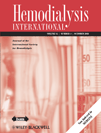The long-term effects of arteriovenous fistula creation on the development of pulmonary hypertension in hemodialysis patients
Abstract
The aim of this prospective study was to evaluate long-term effects of arteriovenous fistula (AVF) on the development of pulmonary arterial hypertension (PAH) and the relationship between blood flow rate of AVF and pulmonary artery pressure (PAP) in the patients with end-stage renal disease (ESRD). This prospective study was performed in 20 patients with ESRD. Before an AVF was surgically created for hemodialysis, the patients were evaluated by echocardiography. Then, an AVF was surgically created in all patients. After mean 23.50 ± 2.25 months, the second evaluation was performed by echocardiography. Also, the blood flow rate of AVF was measured at the second echocardiographic evaluation. Pulmonary arterial hypertension was defined as a systolic PAP above 35 mmHg at rest. Mean age of 20 patients with ESRD was 55.05 ± 13.64 years; 11 of 20 patients were males. Pulmonary arterial hypertension was detected in 6 (30%) patients before AVF creation and in 4 (20%) patients after AVF creation. Systolic PAP value was meaningfully lower after AVF creation than before AVF creation (29.95 ± 10.26 mmHg vs. 35.35 ± 7.86 mmHg, respectively, P: 0.047). However, there was no significant difference between 2 time periods in terms of presence of PAH (P>0.05). Pulmonary artery pressure did not correlate with blood flow rate of AVF and duration after AVF creation (P>0.05). In hemodialysis patients, a surgically created AVF has no significant effect on the development of PAH within a long-term period. Similarly, blood flow rate of AVF also did not affect remarkably systolic PAP within the long-term period.




